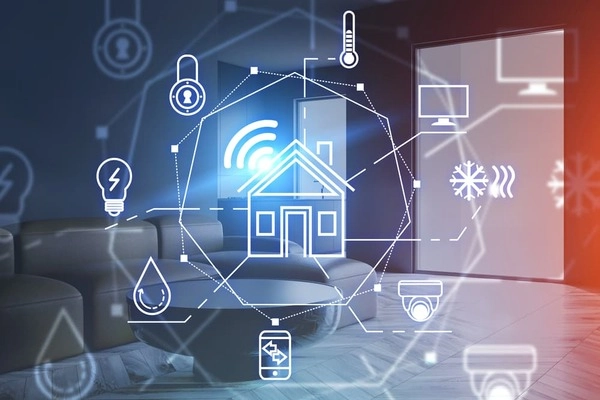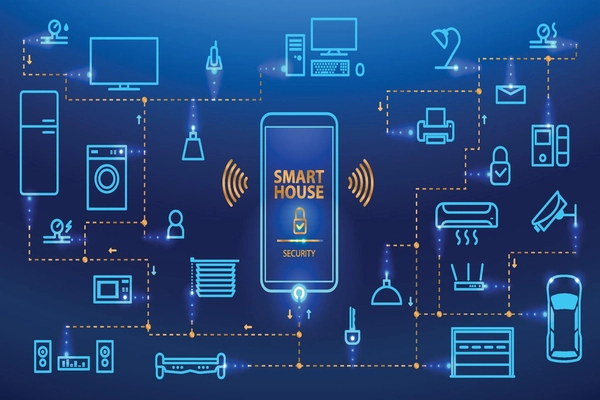In the era of Industry 4.0, IoT Smart Homes are becoming an inevitable trend, transforming traditional houses into convenient, secure, and intelligent living spaces. With the ability to connect, automate, and learn daily routines, IoT devices not only enhance the quality of life but also help save energy, optimize operations, and provide a personalized experience for every family member.
What is an IoT Smart Home?
An IoT Smart Home is a residence equipped with smart devices capable of connecting to the Internet, collecting data, and responding according to user needs. Unlike traditional homes, devices in an IoT Smart Home do not operate independently but are linked into a system, allowing users to control and monitor them remotely through smartphone apps, tablets, or virtual assistants.

Thanks to this connectivity, IoT smart home devices not only perform basic functions but can also automate multiple tasks, learn the daily routines of the household, and thereby enhance convenience while optimizing energy usage.
The Role of IoT in Smart Home Systems
IoT plays a central role in every IoT Smart Home. With IoT, devices no longer operate independently but are connected into an intelligent system. Each device can collect data, send information to a central hub, and execute automated actions.
For example, a light sensor can adjust the brightness of lamps based on ambient light, or a security camera can send instant alerts to the homeowner’s phone when detecting movement. This helps save time, optimize energy consumption, and improve safety. IoT smart home devices can also learn the household’s habits, provide suggestions, or automatically perform suitable actions, creating a modern and convenient living environment.
How IoT Smart Homes Work
An IoT Smart Home operates by connecting smart devices through the Internet and standard communication protocols such as Wi-Fi, Zigbee, Z-Wave, or Bluetooth. These devices communicate with each other and with a central hub (or smartphone app) to carry out automated commands or respond to user requests.

For example, when you leave your home, the system can automatically turn off the lights, lock the doors, and adjust the air conditioning to save energy, while notifying you of your home’s status. Thanks to data collected from IoT smart home devices, the system can learn and predict the household’s needs, creating a personalized and highly convenient living experience.
Key Technologies in IoT Smart Homes
Modern smart homes rely on several core technologies that enable devices to operate intelligently and connect efficiently:
- Sensors and data collection devices: These include motion sensors, light sensors, and temperature sensors, which monitor and respond to the surrounding environment.
- Wireless connectivity: Wi-Fi, Zigbee, Z-Wave, and Bluetooth allow devices to transmit data and communicate seamlessly with each other.
- Artificial Intelligence (AI): AI analyzes data and learns household routines, automatically executing appropriate actions.
- Cloud computing: Cloud platforms store and process large amounts of data, enabling the system to be accessed from anywhere via smartphones or computers.
These technologies form a solid foundation for IoT Smart Homes and IoT smart home devices, allowing them to operate in a coordinated and highly intelligent manner like never before.
Comparison Between Smart Homes and Traditional Homes
The differences between smart homes and traditional homes are quite clear:
| Criteria | Traditional Home | IoT Smart Home |
| Device Operation | Devices operate independently | Devices are connected into an integrated system |
| Control Method | Manual operation | Automated and remote control |
| Ability to Learn Habits | Cannot learn or predict user needs | Can learn household routines and predict user needs |
| Convenience & Security | Limited, dependent on manual operation | Enhanced convenience, energy efficiency, improved security, and better overall living experience |
Thanks to these differences, an IoT Smart Home provides a more convenient, intelligent, and efficient living experience compared to traditional homes.
Applications of IoT Smart Home Devices

Smart Lighting and Energy Management
IoT smart home devices such as smart bulbs can adjust brightness, color, and automated on/off schedules. This not only helps users save electricity but also creates a living environment tailored to their needs and mood. The system can also integrate with light sensors to further optimize energy usage.
Smart Security and Surveillance Systems
Security cameras, motion sensors, smart locks, and doorbells can all be connected within an IoT Smart Home system, sending instant alerts when any unusual activity is detected. This enhances safety, protects property, and keeps family members secure even when you are away from home.
Temperature Control and Energy Efficiency
Smart air conditioners, heaters, and HVAC systems can automatically adjust temperature based on household routines and environmental data. Users do not need to manually adjust each device, while also significantly reducing energy costs.
IoT Applications in Home Entertainment and Convenience
Audio systems, TVs, and other entertainment devices can be controlled via voice commands or smartphone apps. IoT smart home devices help synchronize these devices, creating a seamless and convenient entertainment experience for the entire family.
Health Monitoring and Activity Tracking
IoT devices such as health sensors, smartwatches, and smart scales can monitor heart rate, sleep patterns, calorie intake, and other health metrics. This data is synchronized with the smart home system, allowing users to monitor and improve their daily lifestyle.
Trends and the Future of IoT Smart Homes

Emerging Technology Trends
Current trends in IoT Smart Homes include advanced AI integration, the use of 5G for faster connectivity, eco-friendly smart homes, and multi-functional devices. Additionally, the development of virtual assistants and voice control enhances the user experience, making IoT Smart Homes smarter and more accessible than ever.
Future Development Predictions
In the future, IoT smart home devices are expected to become standard in every household. Smart home systems will not only focus on convenience and security but also prioritize health, sustainability, and comprehensive energy optimization. Integrated, flexible, and personalized solutions will be the main trend, turning every home into a truly intelligent ecosystem.
IoT Smart Homes are transforming the way we live, work, and interact with our environment. From lighting, security, and temperature control to entertainment and health monitoring, IoT devices provide convenience, safety, and energy efficiency. With the continuous advancement of technology, the future of smart homes will become increasingly intelligent, personalized, and user-friendly.
